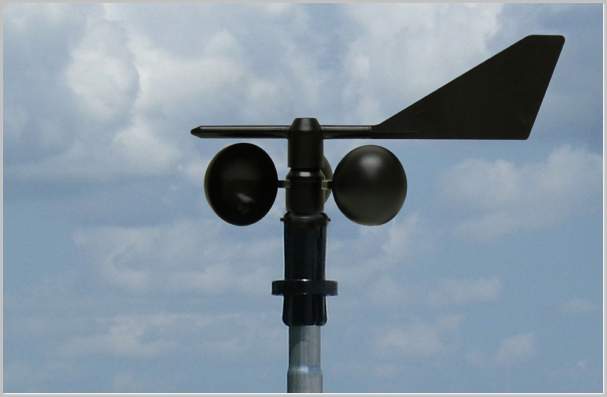Anemometers are simply devices that measure wind velocity or pressure. Although they are simple in nature, the concept is very useful and provide a wealth of information to meteorologists. There is a variety of types of anemometers with their own special features and uses.

How Do They Work?
The general design of anemometers is simple. They generally consist of some form of weather vane with cups or other devices on the ends. These cups are designed to catch the wind and spin the entire setup. A magnet is built into one of the arms and causes a pulse when it passes the reed switch at a certain position. These pulses are recorded and the time between them gives a very accurate estimate of the speed that the wind is moving.
Types Of Anemometers
1) Cup anemometers. The simplest form, these have cups or other bowl shaped devices that move when wind pushes them. They are the original modern anemometer and were developed by Dr. John Robinson of the Armagh Observatory in 1846. Alterations of this model can measure both wind speed and direction by including tags that measure at which point in the spin each cup has the greatest pressure by the wind.
2) Wire anenometers. In this type of anemometer, a wire is heated up and allowed to cool by the wind. How quickly it cools relative to the temperature gives an accurate estimate of the speed of the wind.
3) Sonic anemometers. These use disturbances in sound waves to calculate the velocity of the wind. They are very popular because they require no moving parts, and in turn require little physical maintenance. They are very accurate and can provide a good assessment of wind speed as well.
4) Laser doppler anemometers. This particular type uses laser beams to measure wind speed. A split laser beam can track the speed of debris between two surfaces. Often times some kind of dust or seed material is often introduced to give the lasers something to record.
5) Plate and tube anenometers. These are the oldest form of anemometer, utilizing the pressure of wind on either a plate or a tube of liquid to determine wind speed. Anenometers of this form are not very popular today, as other anemometers are more accurate and efficient. These anenometers are poor at evaluating very low wind speeds, as they do not provide enough force is push the spring that makes the measurement.

